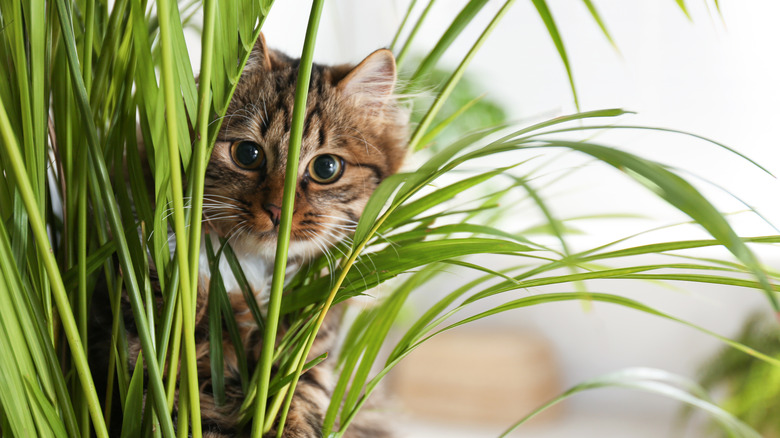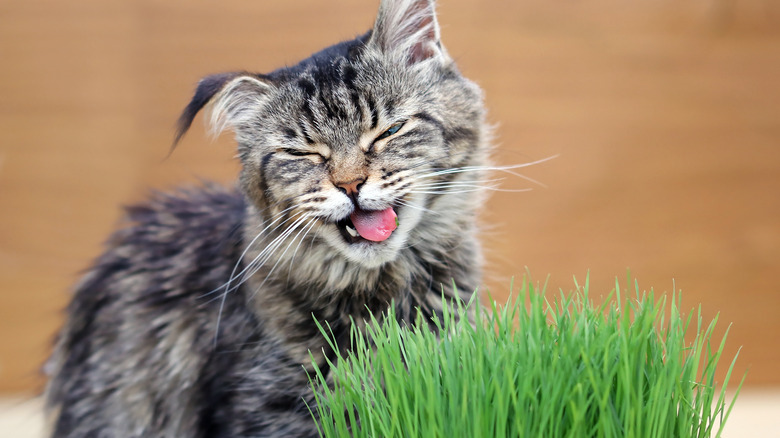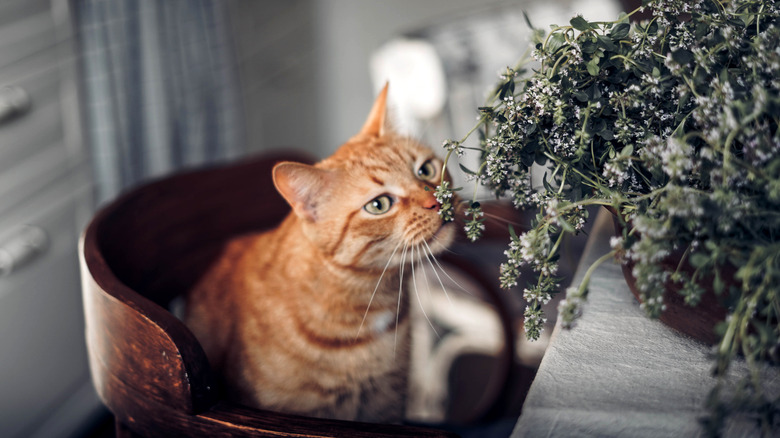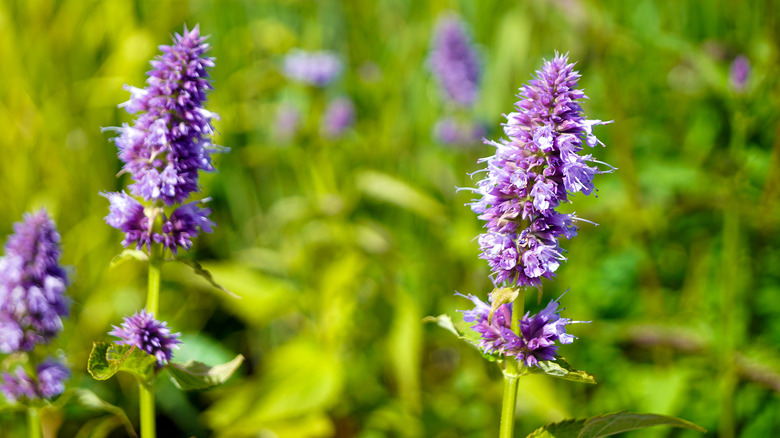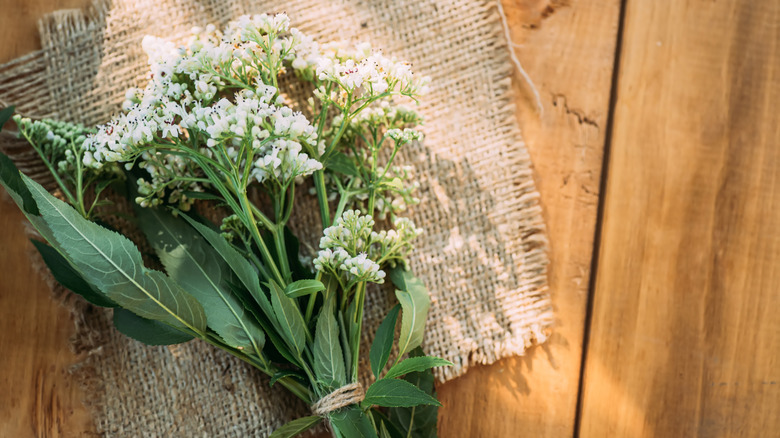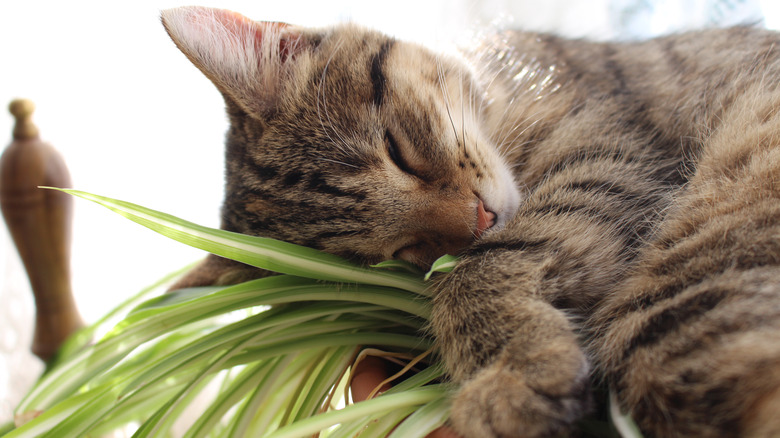5 Plants You Can Grow That Your Cat Will Love
Cats are known for being troublemakers. They love to knock things off counters and nibble on houseplants. Luckily, a fun way to keep your pets away from your toxic plants is to give them their own. Many plants are safe for cats to nibble on and swat. However, you'll still want to monitor the amount your pets are consuming so they don't get an upset stomach.
American Lifestyle explains that you should use organic soil when repotting your cat's plants to protect them from ingesting harmful pesticides. You'll also need to pay extra attention to the size of the pot you choose. If they're too small, the plant will have no room to grow, but if they're too large, your cat can feel tempted to use them as a litter box.
While catnip is often people's first choice when choosing a nontoxic plant for their pet, other options provide the same hallucinogenic effects and benefit to your cat's diet. Here are five plants you can grow — especially for your cats.
1. Cat grass
Cat grass is a plant that benefits your pet's diet. Even though cats are known to be carnivores, this type of grass adds necessary fiber to their meals. Rover explains that cat grass contains vitamins, nutrients, and antioxidants. It's also great at settling upset stomachs because, in large amounts, it will make your pet throw up anything harmful. These unhealthy things could be fur, intestinal parasites, or even feathers and bones from an outdoor cat that went hunting. Pets vomit from cat grass because their stomach doesn't have the necessary enzyme to digest it.
Cat grass is a mixture of wheat, barley, and oat seeds. It can be easily grown indoors for your pet to chew on straight from the pot. Keep the seeds moist for about a week until they sprout. After two weeks, it'll be tall enough for your cat to eat, and you can water it less often. Once the grass starts to wilt, it's time to discard the plant and sprout new seeds.
2. Cat thyme
Cat thyme is an antifungal plant that works similarly to cat grass. It'll also clean your pet's digestive tract of anything harmful they may have ingested. Its antifungal properties are helpful with animals because they can keep them protected from any parasitic worms. Alpha Paw explains that thyme has thymol in it, which is the ingredient that kills the worms. However, if you plan to give your pet thyme, for this reason, consult your vet first.
Cats like thyme because of its pleasant smell and flavor. To grow this plant in your home, it'll need sandy soil and a warm environment. Germinating the seeds is the first step. You can do this by sprinkling them on a bed of soil and keeping them moist. After two weeks, they'll be ready to be planted. Then you can water them less and keep them in bright sunlight (via Grow a Good Life).
3. Licorice root
Licorice root can help your cat's health in many different ways. It's an anti-inflammatory, so it can help relieve a pet with allergies causing itchy skin or an elderly cat with arthritis. Campus Veterinary explains that licorice root is beneficial because it contains cortisone. It's also known for being a mild laxative, which can help stimulate digestion. Licorice root can even be helpful for anxiety-ridden cats because it'll relieve their stress by balancing their cortisol levels, according to Raising Your Pets Naturally. With all its health benefits, it's a plus that cats also like this plant's taste.
Growing this plant isn't difficult, but it'll take around five years to mature. Only then will you be able to harvest it, according to GrowVeg.com. Instead of starting from seed, purchasing this licorice root as a seedling or mature plant is recommended. Then you can let your cat enjoy the plant's benefits sooner.
4. Valerian
Valerian affects cats similarly to catnip. They'll feel the same euphoria that causes them to relieve any stress or anxiety. Valerian is good for cats because it motivates them to play so they can get exercise. It causes them to meow, pounce, roll, and lick. All these behaviors can be beneficial to an overweight cat that wants to lay around all day. Meowy Janes explains that this plant will affect your pet for about five to 30 minutes, and if they're still kittens, it may not affect them at all.
Growing valerian is relatively easy. According to Johnny's Selected Seeds, it will take at least a week for the seeds to germinate, and then you can plant them in well-draining soil. Valerian prefers partial sun and needs frequent waterings. You can give your cat access to the plant or chop it into pieces and put it in their toys like you would with catnip.
5. Spider plant
Spider plants are an option for your cat that'll benefit you and them. They're common houseplants because of their beautiful striped foliage that adds a pop of color to your decor. While they look pretty to you, they look like a fun toy to your cat. The bouncy leaves are irresistible to bored cats who won't be able to stop themselves from swatting and playing with them. Your pets can also nibble on spider plants because they're not toxic. However, Excited Cats explains that cats shouldn't consume large amounts or only eat this plant.
Cats are also attracted to the spider plant because it's a mild hallucinogenic, like catnip and valerian. Once your cat takes a couple of bites of a spider plant, it'll want to play with the dangling foliage even more. To care for this plant, you should give it moderate, indirect sunlight and water it weekly, according to the Old Farmer's Almanac.
